NCERT Solutions for Class 7 Maths - Visualising Solid Shapes- 1
| Table of contents |

|
| Exercise 13.1 |

|
| Exercise 13.2 |

|
| Exercise 13.3 |

|
| Exercise 13.4 |

|
Exercise 13.1
Question 1:
Identify the nets which can be used to make cubes (cut out copies of the nets and try it):






Answer 1:
Cube’s nets are (ii), (iii), (iv) and (vi).
Question 2:
Dice are cubes with dots on each face. Opposite faces of a die always have a total of seven dots on them.
Here are two nets to make dice (cubes); the numbers inserted in each square indicate the number of dots in that box.


Insert suitable numbers in the blanks, remembering that the number on the opposite faces should total to 7.
Answer 2:


Question 3:
Can this be a net for a die? Explain your answer.
Answer 3:
No, this cannot be a net for a die.
Because one pair of opposite faces will have 1 and 4 on them and another pair of opposite faces will have 3 and 6 on them whose total is not equal to 7.
Question 4:
Here is an incomplete net for making a cube. Complete it in at least two different ways. Remember that a cube has six faces. How many faces are there in the net here? (Give two separate diagrams. If you like, you may use a squared sheet for easy manipulation.)
Answer 4:
There three faces are given:


Question 5:
Match the nets with appropriate solids:








Answer 5:




Exercise 13.2
Question 1: Use isometric dot paper and make an isometric sketch for each one of the given shapes:



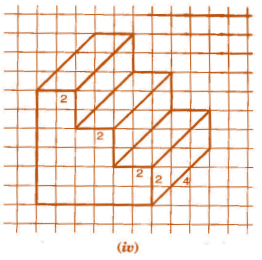
Answer 1:

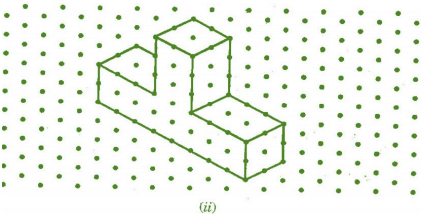

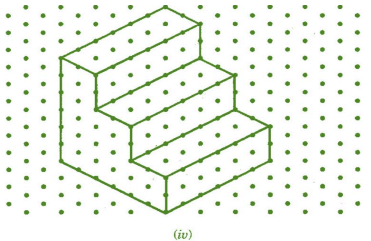
Question 2:
The dimensions of a cuboid are 5 cm, 3 cm and 2 cm. Draw three different isometric sketches of this cuboid.
Answer 2:
The dimensions of given cuboid are 5 cm, 3 cm and 2 cm:
Three different isometric sketches are:
Question 3:
Three cubes each with 2 cm edge are placed side by side to form a cuboid. Sketch an oblique or isometric sketch of this cuboid.
Answer 3:
Oblique sketch:
Isometric sketch
Question 4:
Make an oblique sketch for each one of the given isometric shapes:
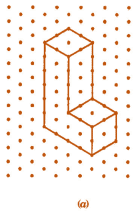

Answer 4:
Oblique sketches:


Question 5:
Give
(i) an oblique sketch and (ii) an isometric sketch for each of the following:
(a) A cuboid of dimensions 5 cm, 3 cm and 2 cm. (Is your sketch unique?)
(b) A cube with an edge 4 cm long.
Answer 5:
(a) A cuboid of dimensions 5 cm, 3 cm and 2 cm.
(i) Oblique sketch

(ii) Isometric sketch

(b) A cube with an edge 4 cm long.
(i) Oblique sketch

(ii) Isometric sketch
Question 6:
An isometric sheet is attached at the end of the book. You could try to make on it some cubes or cuboids of dimensions specified by your friend.
Answer 6:
Cubes and cuboids shapes on isometric sheet given below:

You can also draw more shapes of cubes and cuboids.
Exercise 13.3
Question 1:
What cross-sections do you get when you give a:
(i) vertical cut (ii) horizontal cut to the following solids?
(a) A brick
(b) A round apple
(c) A die
(d) A circular pipe
(e) An ice-cream cone.
Answer 1:
| S.No. | Name of article | Figure | Vertical cut | Horizontal cut |
| (a) | A brick |  |  |  |
| (b) | A round apple |  |  |  |
| (c) | A die |  |  |  |
| (d) | A circular pipe |  |  |  |
| (e) | An ice-cream cone |  |  |  |
Exercise 13.4
Question 1:
A bulb is kept burning just right above the following solids. Name the shape of the shadows obtained in each case. Attempt to give a rough sketch of the shadow.
(You may try to experiment first and then answer these questions).

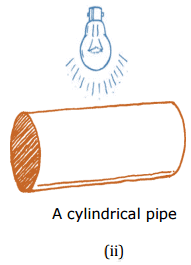

Answer 1:
| S.No. | Object | Shadow | Shape's name |
| (i) | A ball |  | Circle |
| (ii) | A cylindrical pipe |  | Line |
| (iii) | A book |  | Rectangle |
Question 2:
Here are the shadows of some 3-D objects, when seen under the lamp of the overhead projector. Identify the solid (s) that match each shadow.
(There may be multiple answers for these!)



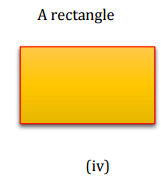
Answer 2:
| S. No. | Shadow | Shape's Name | 3-D objects |
| (i) |  | Circle | Chapatti, Football, Disc, Plate etc. |
| (ii) |  | Square | Die, Square paper sheet, cubical magic box, Chalk box etc. |
| (iii) |  | Triangle | Ice-cream cone, Birthday cap, etc. |
| (iv) |  | Rectangle | Geometry box, Book, Table etc. |
Question 3:
Examine if the following are true statements:
(i) The cube can cast a shadow in the shape of a rectangle.
(ii) The cube can cast a shadow in the shape of a hexagon.
Answer 3:
(i) True
(ii) False
|
76 videos|452 docs|39 tests
|
FAQs on NCERT Solutions for Class 7 Maths - Visualising Solid Shapes- 1
| 1. What are the main topics covered in NCERT Solutions for Visualising Solid Shapes Class 7? |  |
| 2. How can NCERT Solutions for Visualising Solid Shapes Class 7 help in exam preparation? |  |
| 3. Are the NCERT Solutions for Visualising Solid Shapes Class 7 easy to understand for students? |  |
| 4. Can NCERT Solutions for Visualising Solid Shapes Class 7 be accessed online? |  |
| 5. How can students make the most of NCERT Solutions for Visualising Solid Shapes Class 7 while preparing for exams? |  |
















